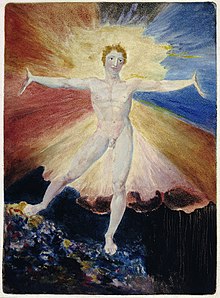Stanley Littlejohn

Stanley Littlejohn (1876–1917) was an English painting
conservator and restorer. He is best known for his work on Tintoretto's sketches,[1] and for his restoration of a number of paintings and drawings by William Blake, including Glad Day[2] and The Ghost of a Flea
.
Born in
National Portrait Gallery on two occasions, when he worked on pieces by John Constable, George Richmond and Alfred Stevens.[4] He served with the Royal Engineers during the First World War. On his eighth day of active combat, he was killed when he was struck on the head by shrapnel from a shell which had exploded close to him.[3]
On his death, he was described as a "uniquely gifted craftsman and valuable public servant", who in his field "had no rival anywhere".[4] In 1918, The Burlington Magazine wrote that "each artist of this rank leaves an actual void which can never be filled by anyone else".[6]
Notes
- ^ "The British Library general catalogue of printed books 1976 to 1982". British Library, 1983. 66
- ^ Bindman, David. William Blake: catalogue of the collection in the Fitzwilliam Museum, Cambridge. Fitzwilliam Museum, 1970. 37
- ^ a b Laurence and Colvin, 16-19
- ^ a b c "British picture restorers, 1630-1950 - L". National Portrait Gallery. Retrieved on 17 January 2010.
- ^ Helen Wang, Helen Persson and Frances Wood, "Dunhuang Textiles in London: a history of the collection" in Helen Wang (ed.) Sir Aurel Stein: Colleagues and Collections, British Museum Research Publication 184, 2012.https://www.britishmuseum.org/pdf/19_Wang-Persson-Wood.pdf
- ^ Veitch, 37-38
Bibliography
- Binyon, Laurence and Colvin, Sidney. "The Late Stanley William Littlejohn". The Burlington Magazine for Connoisseurs, Volume 32, No. 178, January 1918.
- Veitch, H. N. "The 'Jerusalem Dish' at Sotheby's". The Burlington Magazine for Connoisseurs, Volume 33, No. 184, July 1918.
